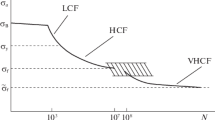Conclusions
A brief analysis was made of the concept of damage in mechanics, and promising directions for further development of this idea were determined. The applicability of the linear damage summation hypothesis was evaluated.
A nonlinear model of damage accumulation was constructed for high-temperature cyclic loading and a base experiment was set up. Solutions were obtained for unidimensional problems of fatigue failure and failure under different conditions of alternation and interaction of creep and fatigue.
Similar content being viewed by others
Literature Cited
V. V. Bolotin, Statistical Methods in Structural Mechanics [in Russian], Stroizdat, Moscow (1961).
V. V. Bolotin, Prediction of the Safe Life of Machines and Structures [in Russian], Mashinostroenie, Moscow (1984).
J. Boyle and J. Spence, Analysis of Stresses in Structures during Creep [Russian translation], Mir, Moscow (1986).
V. P. Golub, Cylic Creep of Heat-Resistant Nickel Alloys [in Russian], Naukova Dumka, Kiev (1983).
V. P. Golub, “Time to failure under conditions of interacting creep and fatigue,” Mashinovedenie, No. 1, 69–74 (1985).
A. A. Il'yushin, “On one theory of rupture strength,” Mekh. Tverd. Tela, No. 3, 21–35 (1967).
L. M. Kachanov, “Time to failure under creep conditions,” Izv. Akad. Nauk SSSR, Otd. Tekh. Nauk, No. 8, 26–31 (1958).
L. M. Kachanov, Principles of Fracture Mechanics [in Russian], Nauka, Moscow (1974).
Yu. N. Rabotnov, “Mechanism of delayed fracture,” in: Problems of the Strength of Materials and Structures [in Russian], Izd. AN SSSR, Moscow (1959), pp. 5–7.
Yu. N. Robotnov, Creep Problems in Structural Members, Elsevier, New York (1969).
A. A. Griffith, “The phenomena of rupture and flow in solids,” Philos. Trans. R. Soc. London Ser. A,211, 163–198 (1920).
N. J. Hoff, “The necking and rupture of rods subjected to constant tensile loads,” J. Appl. Mech.,20, No. 1, 105–108 (1953).
M. A. Miner, “Cumulative damage in fatigue,” J. Appl. Mech.,12, No. 1, A159-A164 (1945).
S. Murakami, and T. Imaizumi, “Mechanical description of creep damage state and its experimental verification,” J. Theor. Appl. Mech.,1, No. 5, 743–761 (1982).
A. Palmgren, “Die Lebensdauer von Kugellagern,” Z. Ver. Dtsch. Ind.,68, No. 14, 339–341 (1924).
E. L. Robinson, “Effect of temperature variation on the longtime rupture strength of steels,” Trans. ASME,74, No. 5, 777–780 (1952).
Additional information
Institute of Mechanics, Academy of Sciences of the Ukrainian SSR, Kiev. Translated from Prikladnaya Mekhanika, Vol. 23, No. 10, pp. 19–29, October, 1987.
Rights and permissions
About this article
Cite this article
Golub, V.P. Damage and unidimensional problems of failure under cyclic loading conditions. Soviet Applied Mechanics 23, 914–923 (1987). https://doi.org/10.1007/BF00900143
Received:
Issue Date:
DOI: https://doi.org/10.1007/BF00900143




